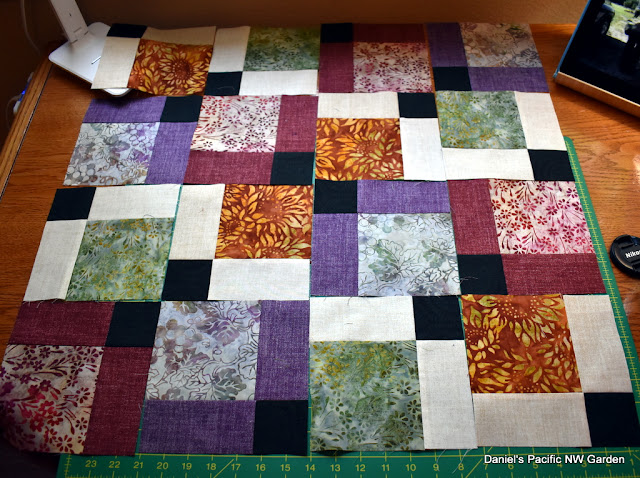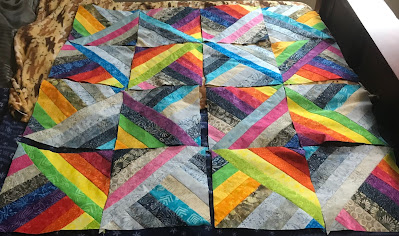These are the fabric samples that I will use for the next quilt. There are two sets. One is a subtle pattern in plain colors. The other set is more vibrant, batiks. They are "fat quarters", fabric cuts sold to make quilts or other projects. I bought them on the internet, not wanting to venture out to the local coronavirus fabric store. With the fabric bundles, you kind of have to make the best guess and take what they package together, so not all of them work. I think most of these will.
This should be enough for a queen size bed quilt. I won't know for sure until I see how it fits together. The pattern will be what is called a Disappearing Nine Patch, a popular pattern that a relative newcomer to quilting can do. It's basically, cut / arrange / sew into blocks, cut again, rearrange, sew into blocks, then arrange and make the quilt top from that.
These are the fabric pieces that I want to use. They are folded, so when I cut them into 5 inch squares, each piece will make about 24 squares (I think). I tried to pair each batik piece with a semi-plain one that is either lighter or darker, and has a color that contrasts or matches the batik piece.
For practice, I cut up some mail order nursery catalog photos. The color one is from
Baker Creek Heirloom Seeds, and the black and white one is from
Fedco nursery. Those are two of my three favorite sources of seeds and plant resources. The Baker Creek photos are the most beautiful in the catalog business, by far. Fedco gives the most interesting history and background info of any catalog of its type. My opinion. My third favorite source is
Victory Seeds, which doesn't have a paper catalog this year due to the pandemic. More about them, later.
I cut the catalog pieces into 5 X 5 squares. I used black and white to contrast with the color photos.
I arranged for the red based images to be at the corners, and the green one in the center. The black and white are in the middle of each side. There is no law that says they have to be in this pattern, or any other, but it's easier to follow when one is learning. The squares can be any color or location.
By having the different color, green, in the center, we can see what happens to that patch.
Then I tape together by threes. With fabric, I would sew with a 1/4 inch seam allowance.
Then join together the three strips of three. This is called a "nine patch" block, one of the main standards of traditional quilts. I could stop there, and make a pile of these quilting blocks, and it wold be a "Nine Patch Quilt". That would be fine as is, but I like the added sense of movement and playfulness of what happens next.
Now, cut the nine patch into quarters. The "nine patch" disappears due to the cut, so now it will become a "disappearing nine patch". So then, instead of a roughly 14 inch by 14 inch square, you have four roughly 7 inch squares.
This image is right after the cuts. What's nice is, instead of all of the squares being squares, now there are big squares, that will come out about 4 X 4 inches, little squares that will be 2 X 2 inches, and rectangles 2 X 4 inches. What pattern and color comes out in what shape and size is up to the person making the quilt. Here, the green flowers are now the smaller squares.
One way to rearrange the squares is to turn two opposite squares so that the small squares are at outer corners. If you wanted, you could do this using all four from the patch that you just cut, or using patches of different colors from all over the quilt. I have not decided yet.
Or, turn so that the small squares are at the outside corners. Then it's like there are four big squares in the center, with a kind of border of black & white rectangles and green small squares in the outside corners.
Or totally random, or any other pattern. Again, there are no laws about any of this. Another option is instead of cutting at right angles, those cuts can be corner to corner, but I'm not doing that this time.
I have black batik that will be the center, so it will be a kind of accent like bow ties all over the quilt. I'm not sure if I will do a random arrangement or try to make a more planned pattern yet.








































